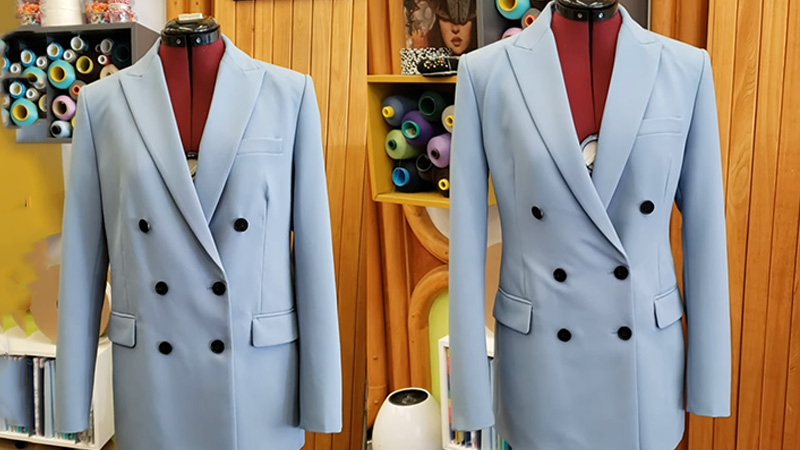Altering a blazer that is either too big or too small can be a sartorial lifesaver, allowing you to breathe new life into a beloved piece or make the most of a thrift store find.
Whether you’re navigating weight fluctuations or simply seeking a personalized fit, the art of blazer alteration is a valuable skill. In this comprehensive guide, we will walk you through the step-by-step process of transforming an ill-fitting blazer into a perfectly tailored garment.
From adjusting the waist and shoulders to resizing the chest and back, we will cover all the techniques needed to achieve that ideal fit. Say goodbye to baggy or restrictive blazers and hello to a wardrobe staple that complements your style and physique flawlessly.

How to Alter a Blazer That Is Too Big or Small?
Altering a blazer that is either too big or too small can be a transformative and practical skill for anyone who appreciates a well-fitted wardrobe. Whether it’s a cherished piece that no longer fits or an exciting thrift store find that needs adjustments, the process of altering a blazer can breathe new life into your clothing collection.
Here’s a comprehensive guide on how to successfully alter a blazer to achieve the perfect fit, regardless of whether it’s too big or too small:
Altering a Blazer That is Too Big:
Altering a blazer that is too big is a practical way to ensure a better fit and breathe new life into a wardrobe staple. Whether you’ve recently lost weight, acquired a blazer that doesn’t quite fit, or simply want to customize the fit of a store-bought blazer.
Here’s a step-by-step guide on how to make the necessary adjustments:
Evaluate the Fit
Before you start making alterations, it’s essential to assess the blazer’s fit. Put on the blazer and identify the areas that are too big. Pay attention to the shoulders, chest, waist, sleeves, and length.
Take note of how much adjustment is needed in each area to achieve the desired fit.
Cinch the Waist
If the blazer is too loose around the waist, cinching it in can create a more flattering silhouette. Turn the blazer inside out and put it on. Use pins to gather and mark the excess fabric on both sides of the waist, ensuring the adjustments are symmetrical.
Remove the blazer and sew along the marked lines, gradually tapering the stitch toward the original seam. Trim any excess fabric and finish the seams to prevent fraying.
Taper the Shoulders
Shoulders that are too wide can make the blazer look oversized. Turn the blazer inside out and put it on. Use pins to mark how much you want to take in from each shoulder, ensuring the adjustments are symmetrical.
Remove the blazer and sew along the marked lines, gradually tapering the stitch toward the original shoulder seam. Trim any excess fabric and finish the seams.
Resize the Chest and Back
To create a slimmer fit in the chest and back areas, turn the blazer inside out and put it on. Use pins to gather and mark the excess fabric in the chest and back, ensuring symmetrical adjustments.
Remove the blazer and sew along the marked lines, tapering the stitch toward the original seams. Trim any excess fabric and finish the seams.
Narrow the Sleeves
Wide sleeves can make the blazer appear oversized. Turn the blazer inside out and put it on. Use pins to mark how much you want to take in from the sleeves, ensuring even adjustments on both sides.
Remove the blazer and sew along the marked lines, gradually tapering the stitch toward the original sleeve seam. Trim any excess fabric and finish the seams.
Shorten the Length
If the blazer is too long, it can overwhelm your frame. Measure the desired length and mark it with pins or chalk. Carefully cut along the marked line, ensuring it’s even all around.
Fold and press a new hem, then sew it in place.
Final Fitting and Ironing
After making all the alterations, try on the blazer once more to ensure it fits perfectly. Make any final adjustments if necessary. Iron the blazer to give it a polished and neat appearance.
This step not only sets the seams but also ensures a professional finish.
Altering a Blazer That is Too Small:

Altering a blazer that is too small can be a bit more challenging than resizing a larger blazer, but it’s still possible to achieve a better fit with some careful adjustments.
Here’s a step-by-step guide on how to alter a blazer that is too small:
Evaluate the Fit
Before you begin any alterations, put on the blazer and assess which areas are too small. Pay attention to the shoulders, chest, waist, sleeves, and overall length.
Determine how much adjustment is needed in each area for a more comfortable fit.
Let Out Seams
One of the most common methods for making a blazer larger is to let out the seams. Locate the side seams and any other relevant seams that need to be adjusted.
Check the seam allowances to see if there’s any extra fabric available. If there is, carefully remove the stitching using a seam ripper or small scissors.
Add Fabric Panels
If there’s not enough fabric to let out the seams, you can add fabric panels to create more room. Choose a fabric that matches the blazer’s color and material.
Cut fabric panels that match the areas you want to expand (e.g., the sides, under the arms). Sew the fabric panels onto the blazer’s seams, making sure to blend the seams seamlessly with the original fabric.
Expand the Shoulders
Expanding the shoulder width can be more challenging. If you’re handy with sewing, you can remove the shoulder pads if they exist and add fabric to the shoulder area to create a broader look.
This requires careful disassembly and reassembly of the shoulder area, so consider seeking professional help if you’re uncertain.
Resize the Chest and Back
If the chest and back are too tight, you may need to add fabric to these areas as well. This process is similar to adding fabric panels to the sides.
Cut fabric pieces to match the areas that need adjustment and sew them in place.
Lengthen the Sleeves and Body
If the sleeves and overall length are too short, you can add fabric or decorative trim to extend them. Choose a matching or complementary fabric and carefully sew it to the sleeve cuffs and hem to achieve the desired length.
Final Fitting and Ironing
After making the necessary alterations, try on the blazer again to ensure it now fits comfortably. Make any final adjustments if needed. Iron the blazer to give it a polished appearance and set the seams.
How to Determine the Ideal Blazer Length?

Determining the ideal blazer length is a crucial step in achieving a polished and stylish appearance. The length of a blazer can significantly impact your overall look, so it’s essential to consider various factors to find the perfect fit for your body type, style, and occasion.
Here’s a comprehensive guide on how to determine the ideal blazer length:
Assess Your Body Type
Begin by understanding your body type. If you have longer legs, consider a shorter blazer to accentuate them. Conversely, those with shorter torsos might opt for a shorter blazer to elongate their appearance.
Body type plays a pivotal role in determining the most flattering blazer length.
Experiment With Proportions
Stand before a mirror and try on blazers of varying lengths. Observe how each length affects your proportions. This hands-on approach lets you visually assess which length harmonizes best with your body’s unique shape and dimensions.
Know the Standard Lengths
Familiarize yourself with standard blazer lengths: short, regular, and long. Short blazers are casual and trendy, while regular-length blazers are versatile and suited for most occasions.
Long blazers convey formality. Understanding these options provides a foundation for your decision.
Consider Your Height
Height matters in choosing the right blazer length. Taller individuals can embrace longer blazers for an elegant look, while shorter individuals may prefer shorter blazers to maintain proportionality.
Keep your height in mind when making your choice.
Reflect on Your Style Preferences
Your style influences your blazer length. Classic and timeless styles pair well with regular-length blazers, while shorter blazers add a contemporary edge.
Consider how your style aligns with the blazer length that complements it best.
Factor in the Occasion
The occasion guides your blazer length selection. Short blazers are often casual, while long blazers exude formality. Consider where you plan to wear it most frequently, ensuring it aligns with the dress code of those events.
Seek Visual Balance
Look for a blazer length that achieves visual balance. It should neither cut your body in half nor overwhelm your frame. The goal is to find a length that complements your proportions, creating a well-balanced and appealing look.
Test With Different Outfits
Experiment with various outfits, mixing and matching the blazer with different tops, bottoms, and shoes. This practical approach helps you gauge how the blazer length interacts with your entire ensemble and ensures it’s versatile for various occasions.
Seek External Opinions
Don’t hesitate to seek input from trusted individuals or a professional stylist. Outside perspectives can provide valuable insights to aid your decision-making process.
Consider Tailoring Options
If you adore a blazer but it doesn’t meet your ideal length, remember that tailoring is an option. Skilled tailors can make adjustments to achieve the perfect length, ensuring your blazer fits impeccably and enhances your overall appearance.
Is It Possible to Make a Blazer Smaller Without Affecting the Shoulder Fit?
Making a blazer smaller without altering the shoulder fit can be challenging. The shoulder area is a critical aspect of a blazer’s structure and shape, and significant adjustments may compromise its overall look and comfort.
However, minor alterations like taking in the waist and sides can be made without directly impacting the shoulders. Consult a skilled tailor who can assess the blazer’s construction and determine if minor adjustments are possible while preserving the shoulder fit.
FAQs
Can I alter a blazer that is too big or too small myself?
Yes, with basic sewing skills and patience, you can make simple alterations. Complex changes may require professional tailoring.
How do I make a too-big blazer smaller without affecting the shoulders?
Focus on waist, chest, and back adjustments, and consider tapering sleeves and shortening the length. Be cautious with shoulder alterations.
Is it better to alter a blazer that’s too big or too small?
It’s generally easier to alter a blazer that’s too big since you can take in fabric and adjust the fit. Altering a too-small blazer can be more challenging but is still possible with careful adjustments.
What can I do if my blazer is too small?
Let out seams if possible, add fabric panels, or extend sleeves and body length. Complex changes, like shoulder adjustments, may need professional help.
What tools do I need for blazer alterations?
You’ll need pins, a sewing machine or needle and thread, scissors, chalk or fabric marker, and an iron for pressing.
To Recap
The ability to alter a blazer that is too big or too small is a valuable skill that empowers you to breathe new life into your wardrobe and create personalized, well-fitting ensembles.
This guide has provided a comprehensive roadmap for achieving the perfect fit, addressing issues ranging from loose waists and wide shoulders to tight chests and short sleeves.
By following these steps with patience and precision, you can transform an ill-fitting blazer into a tailored masterpiece that not only enhances your appearance but also boosts your confidence.
The art of blazer alteration opens up a world of possibilities, allowing you to make the most of your clothing, whether it’s a vintage treasure or a staple from your closet.
Embrace the journey of customization, and enjoy the satisfaction of wearing a blazer that feels like it was made just for you.
Leave a Reply